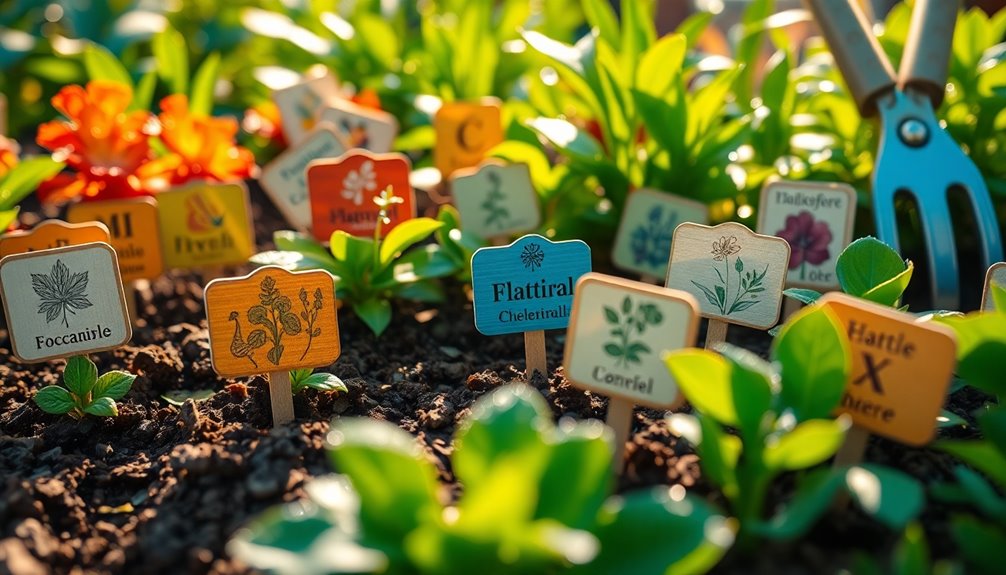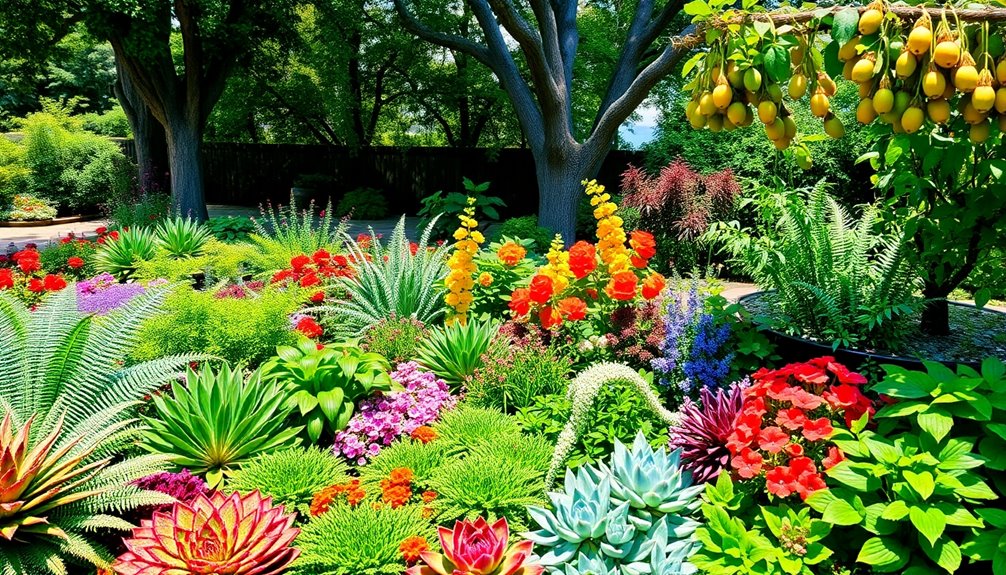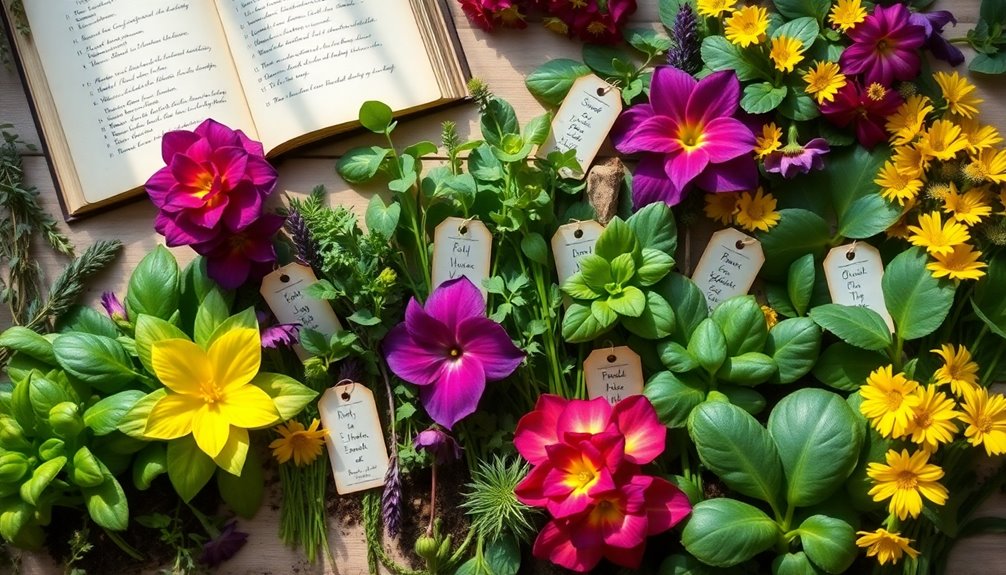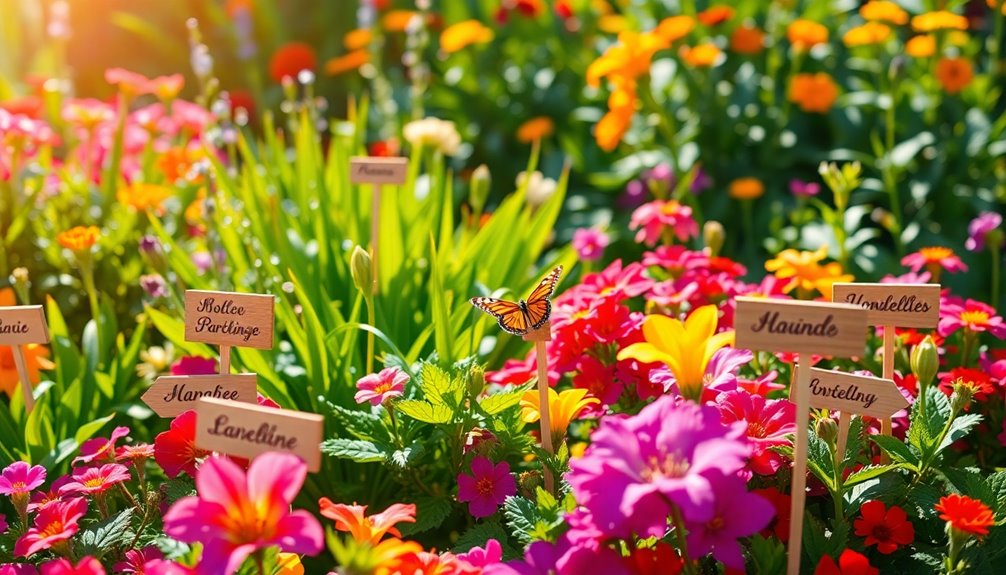You’ve found the ultimate A-Z plant names guide, a crucial resource for any gardener looking to master plant identification and care. This thorough guide features over 4,000 plants, complete with up-to-date botanical names and common names for easy reference. You’ll appreciate the included pronunciation guide, making it easier to communicate about your favorites. From succulents to flowering plants, it covers diverse categories and provides essential care tips to help your garden thrive. With insights from expert botanists and positive reader testimonials, there’s much to explore that can enhance your gardening journey. Whether you’re a beginner or an experienced horticulturist, this guide serves as the ultimate plant names for gardening reference that will elevate your skills. Each entry includes detailed descriptions, ideal growing conditions, and potential pest issues to ensure you are well-prepared. Armed with this knowledge, you’ll be empowered to choose the best plants for your environment and create a vibrant, flourishing garden.
Key Takeaways
- The guide features over 4,000 garden plants with updated botanical names for accurate identification and easy reference.
- Pronunciation guides with phonetic spellings help gardeners communicate plant names effectively, enhancing knowledge sharing.
- Care tips for various plant types, including succulents and flowering plants, ensure optimal growth and maintenance.
- Historical context and plant naming conventions enrich understanding of plant relationships and origins, enhancing the gardening experience.
- Authored by botanist Allen J. Coombes, the guide is recognized for its clarity and usefulness in plant identification.
Overview of Plant Names

Understanding plant names is essential for any gardener looking to enhance their gardening skills.
The A to Z of Plant Names serves as a thorough guide, providing over 4,000 commonly grown garden plants for easy identification. You'll discover updated botanical names that reflect the latest revisions, like the reclassification of Asters to Symphyotrichum.
Alongside these scientific names, the guide includes common names, making it user-friendly for gardeners at any level. It also offers insights into species acceptance and plant distribution, enriching your botanical knowledge.
With suggested pronunciations, you can confidently discuss plants with others. This resource is an indispensable tool, helping you navigate the world of gardening with clarity and ease.
Pronunciation Guide

When you're working in the garden, knowing how to pronounce plant names correctly can really enhance your conversations.
The pronunciation guide includes common adjustments and phonetic spellings, making it easier for you to share your knowledge.
For instance, you'll find that Aesculus is now pronounced (ees-kew-loos), simplifying discussions about this beautiful plant.
Common Pronunciation Adjustments
As you explore the world of gardening, you'll notice that common pronunciation adjustments can make a significant difference in how you communicate about plants.
For instance, the botanical name Aesculus has shifted from the older (i-ku-lus) to the more commonly accepted (ees-kew-loos). This handy guide provides clear phonetic spellings alongside scientific names, helping both novice and experienced gardeners grasp the correct pronunciations.
By focusing on these adjustments, you can demystify complex botanical terms and enhance your confidence in discussions. Understanding these changes guarantees you're using current terminology, making it easier to share background information about plants with fellow gardeners.
Embrace these pronunciation adjustments to elevate your gardening conversations!
Phonetic Spelling Examples
A thorough pronunciation guide can be a game changer for gardeners enthusiastic to communicate effectively about their favorite plants. Understanding phonetic spelling helps you master botanical names and guarantees you can share your passion confidently.
Here are three key benefits of this all-encompassing guide:
- Updated Pronunciations: Shift from complex sounds to common usage, like Aesculus (ees-kew-loos) instead of (i-ku-lus).
- Accessible for Everyone: Designed for readers without formal training, empowering gardeners of all backgrounds.
- Identify Plants Easily: With over 4,000 garden plants covered, you'll never struggle to pronounce a name again.
This guide demystifies the world of plant pronunciations, making it easier for you to engage in discussions about your cherished garden plants.
Plant Types and Categories

When it comes to selecting plants, you'll find a world of options in the succulent and flowering categories.
Each type offers unique varieties that can enhance your garden's beauty, from the striking Agave to the vibrant African Daisy.
Let's explore how to choose the right ornamental plants to create stunning landscapes. Additionally, consider incorporating non-toxic large houseplants to ensure a safe environment for pets while enhancing your indoor spaces.
Succulent Varieties Overview
Succulents, with their striking forms and vibrant colors, offer a diverse range of varieties that can enhance any garden or indoor space.
Here are three common types you might consider:
- Agave – Known for its rosette shape and sharp leaves, it's perfect for sunny spots.
- African Milk Tree – Features unique branching, making it a fantastic indoor ornamental.
- Echeveria – Thrives in bright sunlight and showcases stunning colors.
These low-maintenance plants require well-drained soil and minimal watering.
Remember to avoid overwatering to prevent root rot.
For peak growth, use organic fertilizers during the growing season, and guarantee proper spacing for airflow.
With these care tips, you'll enjoy a thriving succulent collection!
Flowering Plant Highlights
Flowering plants bring a burst of color and life to any garden, making them a favorite among gardeners. With over 4,000 flowering plants available, you can explore a diverse range of options like African Daisy and Cattleya Orchids. Each entry in your guide includes botanical names, common names, and essential plant care tips. Understanding species distribution helps you make confident choices for your garden.
Here's a quick overview of a few popular flowering plants:
| Common Name | Botanical Name |
|---|---|
| African Daisy | Arctotis stoechadifolia |
| Cattleya Orchid | Cattleya spp. |
| Amaryllis | Hippeastrum spp. |
| Adonis | Adonis amurensis |
| Geranium | Pelargonium spp. |
This knowledge will empower you to cultivate vibrant blooms!
Ornamental Plant Selection
While selecting ornamental plants, it's essential to take into account the variety of types available, as each category serves a unique purpose in your garden's design.
Here are three key categories to evaluate:
- Flowering Plants: Varieties like Sweet Alyssum and Autumn Sage not only provide vibrant colors but also attract pollinators.
- Foliage Plants: Options such as Fiddle-Leaf Fig and Monstera Deliciosa add lush greenery and texture to your space.
- Shrubs & Ground Covers: Shrubs like Arrowwood Viburnum offer structure and seasonal interest, while ground covers like Ajuga suppress weeds and create a low-maintenance carpet.
Your plant selection should balance aesthetic appeal with functionality, ensuring your garden thrives throughout the seasons.
Care Tips for Gardeners

To keep your garden thriving, it's essential to pay attention to a few key care tips.
Regularly check soil moisture levels to provide adequate water without overwatering, which can cause root rot. Understand the specific sunlight requirements for each plant; some thrive in full sun, while others prefer partial shade.
Use organic fertilizers to nourish your plants, adjusting based on their growth stage and specific needs. Implement effective pest management techniques and monitor for early signs of infestations.
Guarantee proper plant spacing to promote good air circulation and reduce nutrient competition among plants. Additionally, be mindful of regulatory frameworks to combat any shadowy practices that could affect your gardening supplies.
Author and Contributors

Many gardeners benefit from the insights of experts like Allen J. Coombes, a renowned botanist dedicated to enhancing your understanding of plant nomenclature.
His work simplifies complex botanical terms, making them accessible for all skill levels. Here are three reasons why his contributions are essential:
- Expertise in Horticultural Taxonomy: Coombes' extensive knowledge aids in proper plant classification.
- Curator of Scientific Collections: Based in Puebla, Mexico, he curates valuable resources at the University Botanic Garden.
- Focus on Botanical Education: He actively promotes understanding of naming conventions, empowering gardeners to make informed choices.
With his background, including involvement in the Horticultural Taxonomy Group, Coombes enriches the field of botanical education for every gardener.
Reader Testimonials and Reviews

Gardeners everywhere are praising "The A to Z of Plant Names" for its straightforward approach to plant naming.
Reader testimonials highlight its clarity in plant naming and ease of pronunciation, making it a go-to resource for both novices and seasoned gardeners.
With extensive coverage of over 4,000 garden plants, you'll find updated names and classifications that other resources miss.
Many appreciate the historical context and intriguing facts about plant origins, which enrich your understanding of botanical nomenclature.
Reviewers describe it as a practical guide that simplifies complex terms, empowering you with knowledge and confidence in identifying and naming plants correctly.
This book truly transforms the way you engage with your garden. Additionally, engaging with this resource can enhance your understanding of plant naming conventions which can be crucial in effective gardening practices.
Frequently Asked Questions
How Should I Name My Plant?
When you name your plant, start by using its botanical name. This guarantees accuracy, as it reflects its classification.
Don't forget to learn the common names too, since they can differ by region. It's helpful to check updated resources for any recent changes in nomenclature.
Consider the plant's origin to understand its care needs better.
Finally, practice pronouncing the names confidently, so you can share them easily with others.
What Plant Has the Coolest Name?
If you're looking for a plant with a cool name, consider the "Corpse Flower," or Amorphophallus titanum. Its striking name captures attention, and when it blooms, it emits a smell that's anything but pleasant.
Alternatively, the "Dragon Plant" (Dracaena cincta) evokes mythical imagery with its stunning foliage.
Each name tells a story, so pick one that resonates with you and adds character to your garden!
What Plants Grow Best in AZ?
Imagine walking through a desert oasis, where vibrant plants thrive despite the scorching sun.
In Arizona, you'll want to plant drought-tolerant species like Agave and Desert Marigold. Native options like Saguaro Cactus and Arizona Sunflower flourish with minimal water.
For shaded spots, try Lantana or Texas Ranger for a splash of color.
Don't forget succulents like Echeveria and Aloe Vera; they're low-maintenance and perfect for your hot garden paradise!
How Do You List Plant Names?
To list plant names effectively, you should start with the scientific name, italicizing the genus and species (like *Aesculus hippocastanum*).
Next, include common names, as they vary by region. Organizing your list alphabetically by either name type can make it easier to navigate.
Don't forget to add details like the plant's family and characteristics, as this info enriches your list and helps others identify and understand the plants better.
Conclusion
To sum up, you've explored the ultimate A-Z guide to plant names, enhancing your gardening knowledge. Did you know that there are over 390,000 plant species on Earth? With this guide, you'll feel empowered to identify and care for a diverse range of plants, making your gardening journey more enjoyable. So, whether you're a novice or a seasoned gardener, you can grow your green thumb and impress friends with your newfound plant expertise! Happy gardening!









